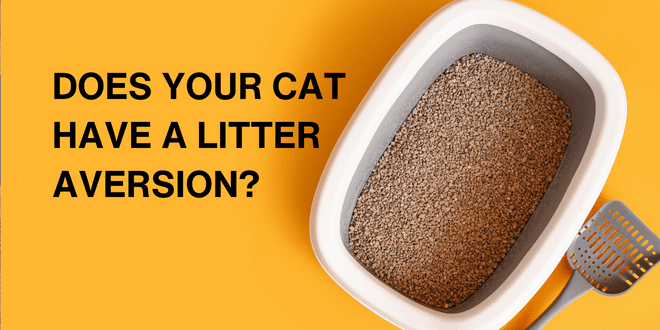
To a cat parent, one litter may be just as good as another. In fact, what humans may find attractive about a particular brand or type of litter may actually be highly disliked by the cat. There are also other factors that come into play when trying to evaluate whether your cat has a litter aversion, or an aversion to the entire set-up. You also have to first rule out any underlying medical causes as they are frequently the reason a cat avoids the box. Other factors that need to be taken into consideration: location of the box, size and type, number of boxes, and of course, whether you’re keeping it clean enough.
How Common is Litter Aversion?
It’s actually relatively common that a cat may eliminate away from the box due to a dislike of the litter or the litter conditions. Even if the cat still faithfully uses the litter box, he may want to spend as little time in there as possible if there’s a dislike of the litter. The cat may not dig or scratch or he may even perch on the edge of the box so the front or back paws don’t have to touch the unpleasant litter.
Common Reasons for Litter Aversion
Texture. Cats are very tactile and they can have very definite preferences when it comes to the way a particular substrate feels on their paw pads. In general, most cats tend to like the soft, sandy feel of scoopable litter. Some litters have sharper granules and some have large ones, or they may even have pellet-type granules. If you’ve recently switched to an alternative litter that has a texture that isn’t soft, that may be an unpleasant change for your cat. Even though a cat’s paw pads may feel rough, they’re actually very sensitive.
Abrupt Changes. Cats are creatures of habit and they take comfort in familiarity and routine. When they go into the litter box they expect to find the same type of litter that they’re used to. If you make an abrupt change in brand, type or scent, it can be confusing and can cause anxiety. Cats don’t want to be surprised when they go to the litter box; cats want consistency. If you decide you want to change brands or types of litter, do it gradually by adding a little of the new litter in with the current brand over the course of a week so your cat has plenty of time to make the adjustment. If you think your cat dislikes the current brand of litter, you can also set up a litter box “buffet” by placing a couple of additional boxes out, filled with other brands of litter. This way, your cat can choose which one is most comfortable.
Dirty Litter. Your cat may not have had a problem with the texture or the type of litter until it started becoming too dirty. One of the most common causes of litter box aversion is due to the cat parent not keeping the litter conditions clean enough. So before you start making changes in the brand or type of litter, take a closer look at the maintenance schedule. Are you scooping the box at least twice a day? Is the box being thoroughly emptied, washed, and refilled with fresh litter on a regular basis? The aversion problem may actually be that the cat doesn’t like stepping on dirty clumps of litter or dried fecal waste. Nobody wants to use an unflushed toilet.
Negative Association. If your cat has a medical problem that causes pain upon urination or defecation, he may have learned to associate that particular litter substrate with discomfort. If you think that’s the case, set out another litter box with a different brand or type of litter. Don’t get rid of the original box though, just add another to give your cat the option. If your cat starts using the new box, then you can get rid of the original one or fill it with the new litter.
Inconsistent Litter Level. Too much or too little litter in the box can create an unpleasant experience for the cat. With too little litter the cat can’t adequately scratch and dig before or after elimination. This can be stressful if the cat feels he can’t cover the scent of waste effectively. If there’s too much litter in the box it can be uncomfortable for the cat to stand or squat during elimination. When you’ve finished scooping the box, spread the litter out to form an even layer. Every few days, add a little fresh litter to the box so the depth remains consistent. Typically, a 3-inch depth is recommended.
Litter Additives. Baking soda as an additive, as long as you don’t use too much, is typically okay for added odor control but the use of other commercial additives that are basically just highly-scented products can cause enough of a scent change to upset your cat. If you scoop the box at least twice daily and maintain an adequate washing schedule, there shouldn’t be an odor. If you have a multicat home and don’t have enough litter boxes, the addition of odor control products won’t solve the problem. With multiple cats, there should be a litter box in each cat’s preferred area of the home so one cat doesn’t have to cross another cat’s path when it’s time to eliminate. The rule of thumb is that litter boxes should outnumber your cats by one. This way, it reduces the chances of intimidation and guarding, and it also doesn’t create so much of an odor problem with one litter box getting overloaded.
Highly Scented Litter. As with litter additives, scented litter is basically created for cat parent appeal. It’s designed to be an odor cover-up. And, as I mentioned above, if you keep the box scooped and clean, there really should be an odor in need of covering up though. A cat’s nose is very sensitive with its 200 million scent receptors (we have 5 million), so imagine how offensive a highly scented litter can be when kitty enters the box. Stick to unscented litter and let your excellent cleaning schedule be the best odor control!
Litter Liners. The plastic liners can make digging and scratching in the litter a very unpleasant experience for a cat with claws. As your cat tries to scratch at the litter he may get claws stuck in the plastic. Additionally, plastic liners can form pockets and folds that can trap urine where it will just cause more of an odor problem. In general, shortcuts don’t work and they can create an aversion problem. If you want to ensure your cat faithfully uses the litter box, you have to create a set-up that’s convenient, clean, and comfortable. Instead of shortcuts, just get the right sized box, fill it with an appealing litter, place it in a convenient location, and keep up on the maintenance.
Need More Information?
For specific help with solving litter box problems, refer to Pam’s books. You can find her books at bookstores and also online. We’ve included Amazon links here on our site.
Note: If you have a question regarding your cat’s health, please contact your veterinarian. This article is not intended as a replacement for your cat’s veterinary care.
 Problem Solving & Advice by Pam Johnson-Bennett Cat Behavior Expert & Best-selling Author
Problem Solving & Advice by Pam Johnson-Bennett Cat Behavior Expert & Best-selling Author




